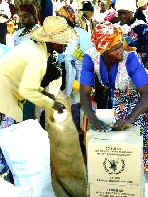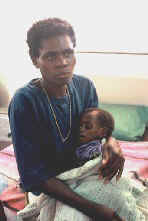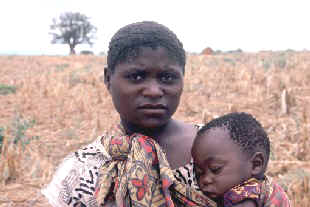|
HUNGER IN SOUTHERN AFRICA: THE UNFOLDING CRISIS
Drought, floods, economic instability
and HIV/AIDS is threatening the food security of millions of people
spread across six countries in southern Africa. WFP is calling for
a massive response to the unfolding crisis.
May 4, 2001 - With southern Africa facing
its worst food shortages in a decade, WFP is gearing up for a massive
humanitarian operation to feed millions of people across the region.
The Agency is already feeding about 2.6 million people in Malawi,
Mozambique, Swaziland, Zambia and Zimbabwe, but a regional cocktail
of drought, floods, depleted foods stocks and economic instability
suggest millions more are falling deeper into hunger.
WFP's regional director for east and southern Africa, Judith Lewis,
has warned that food has to start arriving in three-four months to
avert an "all-out disaster."
"Much needs to be done, and we need to do it now," said Lewis, who
spent 15 days cris-crossing the region last month.
"We need to be preparing for what's going to be needed in the future."
WFP experts are already assessing logistics in the region ahead of
the expected massive food supply operation.

The window to generate
response shrinks by the day. Unless we mobilise urgent, massive
food resources, people will soon start to die.
|
 |
| Judith
Lewis, WFP Regional Director, Southern Africa |
|
 |
In order to quantify the dimensions of
the unfolding crisis,
the Agency is currently running assessment missions across the region
(see box
below) together with other United Nations' Agencies, Governments,
Donors and non-governmental organisations (NGOs).
An appeal is expected to go out to donors in June.
Food security has not touched such low
levels since a severe drought in 1991/92. Then WFP, governments
and commercial operators brought 12.9 million tonnes of food aid
into the region to avert a potential famine.
FIGHTING FOR SURVIVAL
"The situation is extremely critical," says Lewis, who spent 15
days touring the region last month.
The principal threats to food security are many, and vary in severity
from country to country:
- Severe dry spells / drought:
Malawi, Mozambique 2001/2002, Zambia, Zimbabwe.
- Heavy rain / floods:
Lesotho, south & central Mozambique 2000/2001.
- Disruption to commercial farming: Zimbabwe.
- Depletion of strategic grain reserves: Malawi 2001,
Zambia.
- Poor economic performance:
Lesotho, Zimbabwe.
- Delays in importation of maize,
particularly from South Africa:
region-wide
- Sharp rises in price of staple foods:
Malawi, Mozambique, Zambia, Zimbabwe
In many places, this is the second or third
consecutive year of food shortages and many people's so-called 'coping
mechanisms', such as selling livestock to pay for food are exhausted.
Today, they are fighting for survival.
Predictions for the approaching harvests (April-June) are pessimistic;
at best, their yields will only provide short-term relief for some
of the 2.6 million victims.
As if this was not enough, meteorologists are also warning that
the El Nino climatic phenomenon could strike a blow to next year's
harvest.
The current crisis is also unfolding against the backdrop of one
of the world's highest HIV/AIDS rates. Prolonged food shortages
in southern Africa could see an already weakened population succumb
to a variety of illnesses and disease.
"The crisis is upon us and the window of generate response shrinks
by the day," says Lewis, "unless we mobilise urgent, massive food
resources, people will soon start to die."
| WFP
Assessment Missions: 2002 Schedule |
- Zimbabwe: 23 April-11 May
- Malawi: 22 April-10 May
- Zambia:6-24 May
- Mozambique: 22 April-10 May
- Lesotho: 25 April-4 May
- Swaziland: 15-24 April
|
- LESOTHO
Unfolding Crisis:
- Lesotho is facing it's second year of food shortages and,
on April 22, the prime minister declared a state of famine.
- 2002 is expected to be a second year of poor production of
both maize and sorghum because of heavy rains, hailstorms and
frost. Maize is available on the market but prices are extremely
high for this time of year.
- Lesotho is encircled by South Africa. Consequently, this tiny,
mountainous country depends on its neighbour for more than half
its food needs. But South Africa's badly needed food surpluses
have failed to materialise.
- Lesotho's food security was already in decline for two reasons:
First, production of Lesotho's major crops continues to decline,
a trend which started in the 1970s; second, household income
once supplemented by remittances from Basotho employed in South
African mines is falling because of the retrenchment of mine
workers.
- Poverty and malnutrition are particularly pronounced in Lesotho's
mountainous areas. 16.3 percent of children under the age of
five are estimated to be underweight in Lesotho.
- According to the World Bank, HIV prevalence rate in Lesotho
is approximately 26.5 percent (35.3 percent among adults).
WFP Response: WFP is already helping some 36,000 people in
the worst-affected parts of Lesotho through food aid drawn from
its existing development projects.
The operation targets five districts which were badly hit by crop
failure in 2001. By March 31, 432 metric tonnes had been distributed
to 24,000 of the most vulnerable people. However, international
emergency assistance may be required.
back
to the top 

- MALAWI
Unfolding Crisis:
- With more than 70 percent of the
population facing food shortages, the president of Malawi made
his country's food crisis a State of Disaster on February 27.
- Malawi's current food shortages stem from the worst floods
on record in 2001, last season's low maize production, the depletion
of the strategic grain reserve and high maize prices on all
local markets.
The situation has been worsened by a dry spell, a lack of seeds
& fertilisers and, most significantly, families consuming vast
amounts of their harvest when it is still green. Many now risk
running out of their own food soon.
Malawi's lean season usually falls in October. This year, it
is expected to start in June.
- Hungry thieves are stealing entire maize fields; people are
afraid to leave fields unattended while at funerals or weddings.
Men have been risking their lives by diving for water lily bulbs
in crocodile-infested rivers, while women have been gathering
up wild grasses to pound the barely visible kernels into flour.
- ·Malnutrition rates are soaring in health and nutritional
centres. The National Rehabilitation Centre at Blantyre has
received twice the average intake of malnourished patients in
recent months.
- With children kept at home to help their families search for
food, school attendance has dropped.
WFP Response: WFP is currently assisting some 301,000 people
through an emergency operation, in addition to disaster mitigation
activities under its Malawi Country Programme.
back
to the top 

- MOZAMBIQUE
Unfolding Crisis:
- After having their crops and livestock devastated by severe
flooding in 2000 and 2001, the people of south and central Mozambique
are now grappling with the consequences of another natural calamity:
the near total absence of rain since January.
- Almost total crop failure is reported in many parts of the
south, with partial loss in the centre.
Production of Mozambique's staple food maize has suffered. Up
to 400,000 people are already without food stocks, and the situation
is set to deteriorate further.
- For rural families, who rely on subsistence agriculture for
survival, three years of natural disaster has exhausted their
main coping mechanism - the sale of livestock.
Most herds have not recovered from the 2000 floods.
- Food prices are rising and people who cannot afford the staple
food are getting increasingly hungry.
WFP Response: WFP is currently providing food aid to some
191,000 people under its flood 2000 recovery operation; this was
recently extended to allow the Agency to keep helping a population
that once again finds itself at the mercy of a natural disaster.
While awaiting the results of the assessment mission currently in
progress , WFP Mozambique is drawing up a three-month 'bridging
operation' to provide food aid for 400,000 people in need.
back
to the top 

- SWAZILAND
Unfolding Crisis:
- Swaziland is usually self-sufficient but the government
recently declared an urgent need for food aid following erratic
rainfall.
Initial projections indicate a second year of below average
maize production.
- Swaziland relies heavily on South Africa for food supplies
and the latter country's decreased production levels are weighing
heavily.
WFP Response: Although WFP has not been present in Swaziland
since 1996, the Agency is still monitoring the food security situation
carefully. The precise amount of food aid required will be determined
in the upcoming joint assessment mission.
back
to the top 

- ZAMBIA
Unfolding Crisis:
- In southern Zambia, severe drought has caused total crop
failure, even devastating the usually drought-resistant sorghum;
despairing farmers have set their livestock loose to eat up
the dried up stalks.
The drought has also affected the eastern part of Zambia.
- Many Zambians are experiencing their second year of crop
failure and have little or no food stocks to fall back on.
Families are having to use their savings to buy food.
Some are selling their livestock at throw-away prices before
water sources dry up. Others are surviving off the fruit of
baobab trees or eating so-called famine foods such as wild
cucumbers and a boiled root mix.
-
The situation has been further aggravated by developments
in Zimbabwe which have increased the regional demand for
maize; this has pushed the price of Zambia's staple food
beyond the reach of large numbers of people.
-
The April harvest seems unlikely to alleviate food shortages
for many months, with the lean season expected to start
earlier than usual.
WFP Response: WFP assistance to drought-affected populations
has been extended until July 2002; the operation, which provides
for 1.3 million people, has also been adjusted to target the districts
(mainly in the south), which have been worst-hit by this year's
drought.
back
to the top 

- ZIMBABWE
Unfolding
Crisis:
WFP Response: Zimbabwe's government appealed to the UN
for humanitarian assistance in October 2001.
WFP subsequently re-established a Country Office and launched
an emergency operation to target 558,000 people in 19 districts.
Food aid distributions started in February.
To date, relief efforts have been concentrated in rural areas
where food shortages were judged to be the most serious.
However, an Urban Brainstorming Workshop took place in Harare
on April 16-17. Its findings, which recommended the design of
an urban food aid programme for Zimbabwe, have won widespread
consensus.
WFP will be working closely with the Southern African Development
Community (SADC) to revive the Logistics Advisory Centre in Harare;
this coordinated transport & logistics when WFP staved off famine
during the southern African famine of 1991/92.
back
to the top 

|


